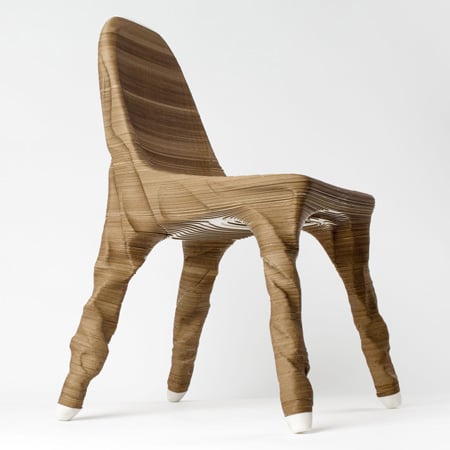
Digital Couture by Hermann August Weizenegger
German designer Hermann August Weizenegger presents his latest project, Digital Couture, at Appel Design Gallery in Berlin later this month.
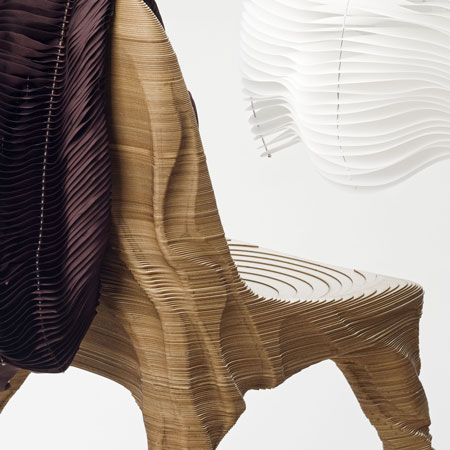
The collection features furniture and objects made up of thin layers of material.
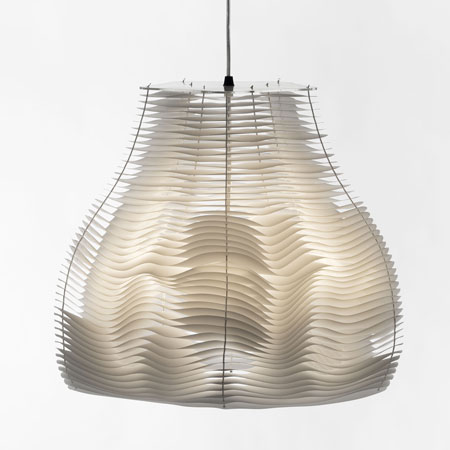
The exhibition runs from 19 September to 10 October at Appel Design Gallery, Torstrasse 114, 10119 Berlin.
Above: Cloud light. Below: Erosio chair
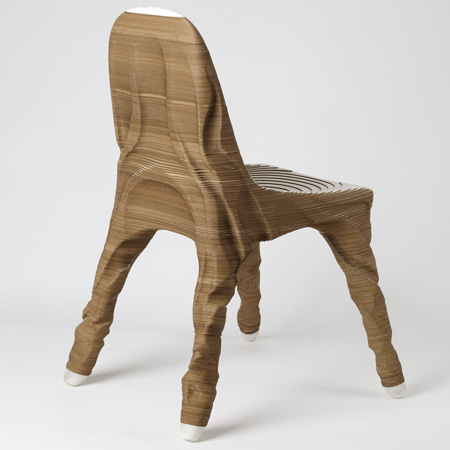
Here's some info from Weizenegger about the show and the collection:
--
APPEL DESIGN GALLERY
Torstrasse 114 · 10119 Berlin · Phone 030 32518160
Exhibition DIGITAL COUTURE
19.09.2009 until 10.10.2009
monday till saturday 12 - 20pm
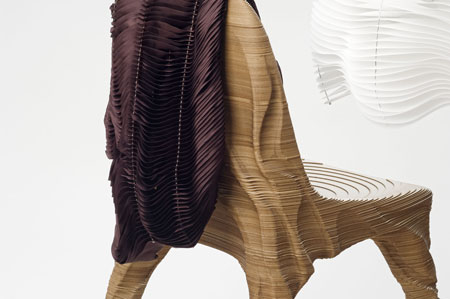
Short version:
Digital Couture is the name given to a group of works on which Hermann August Weizenegger worked together with traditionally trained craftsmen and programmers aided by data-based procedures. All objects in the work group are based on a design principle of layering and turning. Using a variety of materials he created a number of objects such as the Erosio chair, the Muse design sculpture, the Cloud lamp and a dress designed with numerous individual lamella-like components. The aesthetic concept behind the work group lies somewhere between functional design product and autonomous object.
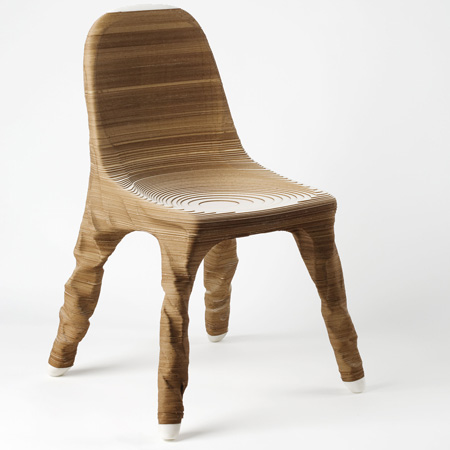
Digital Couture
Digital Couture is the name given to a group of works on which Hermann August Weizenegger worked together with traditionally trained craftsmen and programmers aided by data-based procedures. The design project was preceded by a sort of basic research which addressed the question of whether a design concept developed for a specific object can also be applied in the design of other objects. In this formal aspects such as those occasioned by the technologically defined structure of a design principle play just as crucial a role as the idea of transformation.
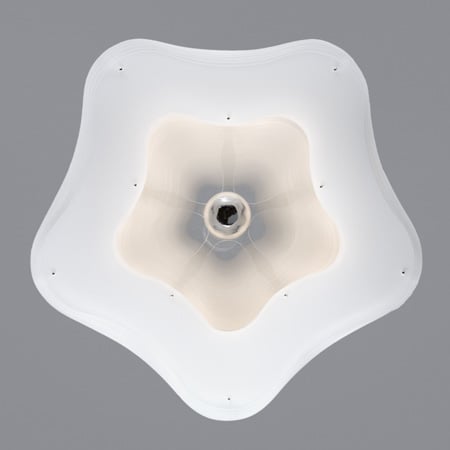
The objects currently presented here are the result of a series of designs based on the principle of layering and turning materials. Using the layering technology the designer created a self-contained group of works that has given rise to various design objects. An initial design sculpture took on the inspiring function of muse, from whose design structure a continuous permutation of new forms and objects developed. The designs made with the help of 3D tools were produced with contemporary technologies such as rapid prototyping and by integrating a traditional handcraft technique such as turning. This ‘reconciliation’ of production techniques not only offers new opportunities for designing objects but also provides long-term stimuli for future production processes in industry and handicrafts. This type of work concept also offers new perspectives from an economic point of view. Individual works from the collection stand out for their valuable materials and craftsmanship and as such are conceivable in limited editions, whereas other design objects using the same design scheme can be mass-produced.
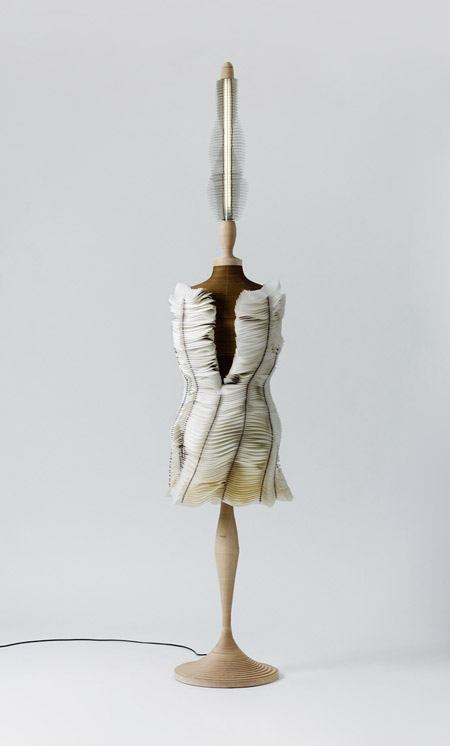
Muse design sculpture (above)
The first object in the work group, Muse, marks the beginning of a complex investigation of the idea of expanding the concept of design - as has been the case with the concept of art since the 1960s - by positions which reflect the media and are critical of institutions The aim here is to scrutinize design as a practice and a concept with regard to the broad spectrum of manufacturing technologies and the constant changes in the production society.
The design sculpture shown here possesses the hybrid character of a design object and a sculpture. The manual skills of the couturier feature in this work just as much as the data-based calculation of layering such as is undertaken with geological and tectonic phenomena. The measuring of the figure, which in the classic process is adjusted to shape by modeling the dress form with muslin, was replaced in this case by a laser procedure which reads and models the contours of a dress on the computer. The feet and head of the form, on the other hand, are traditionally handcrafted by a Berlin turnery. The manner in which the components were then combined together is reminiscent of the laborious craftsmanship of master tailors - as they have been displaying with figurines and models in Paris ateliers since time
immemorial.
Material- silk, cardboard, wood, newsilver
Photo: Bernd Hiepe
Erosio chair
The Erosio chair also emerged from a 3D design and acquires its shape from the layering and turning of material, in this case, layers of paper. As with the other designs, the designer started with the basics of the design sculpture Muse.
The compact arrangement of 900 sheets of paper lends the chair its solid state. A sintered component in the middle of the chair forms the core of a connecting system, to which four circular metal rods are fixed. These constitute the inner structure of the chair. The layers calculated on the computer which form the outer shape of the chair are threaded onto the round rods in an additive process. The individual paper layers are not all fixed to the chair’s legs so that the shape of the chair within the framework of its fixed inner construction can be lightly modified.
The aesthetic appeal of the chair’s finish is determined by sensual characteristics created by the electronic production process, but which in one way is similar to manual production. The precise laser technique with which the cardboard is cut leaves minimal burn marks, spots and fine fraying on the edges barely visible to the eye. As a result of these sutures, which are occasioned by the material and fully intended by the designer the chair assumes a material presence all of its own that is reminiscent of a natural material such as wood or sediment stone. In functional morphology, tectonic and geological layering like this can be found in connection with erosion discordance. The designer is consciously playing here with the demarcation line between nature and artifact.
From the virtual world of a design made using 3D tools an everyday object with high object character emerges, referencing with its sculptural presence the geological circumstances of the real world, a world in which a chair always has its place.
Material- Inside:sintern nylon, metal pipe, Outside: cardboard
Photo: Bernd Hiepe
Edition of 12 Price : 7.900,00 Euro
Cloud lamp
The Cloud lamp gives an impression of lightness and transparency, even though the lampshade was created manually by threading many fine layers of sheets of paper, giving it substantial volume.
The regular line pattern which is created by the layering of transparent and translucent lamellae is interrupted by the softly bent perspectives of the elastic synthetic paper developed in Japan. The lamp, which was developed with the design principle of layering and turning, just like the design sculpture Muse and the Erosio chair, thus acquires a totally different aesthetic quality. The use of laser technology for cutting the translucent material and the lampshade with its complex handcrafting are yet another good reason for combining high tech processes with traditional handcraft.
Material - Plexiglas, YUPO paper
Size: large 420 mm wirth 420 high 420
Foto: Bernd Hiepe
Price 590,00 Euro